
Aust Last WWII Ace - depiction of no. 5 victory

528 - The Enchantress

Kwitcherbitchin in the Clouds

Kwitcherbitchin parked North Field Iwo Jima 1945

542
- HOME
- 506TH STORY
- SQUADRONS
- PILOTS
- IWO TO JAPAN
- MAY/JUNE MISSIONS
- MAY/JUNE MISSIONS
- MAY 28th | TOKYO AREA AIRFIELDS
- JUNE 1st | BLACK FRIDAY 25 Pilots Lost
- JUNE 7th | OSAKA | 138 P-51s of 15th, 21st and 506th Groups
- JUNE 8th | NAGOYA AREA
- JUNE 9th | NAGOYA AREA
- JUNE 10th | TOKYO AREA
- JUNE 11th | TOKYO AREA
- JUNE 14th | BONIN ISLANDS
- JUNE 15th | OSAKA AREA
- JUNE 19th | TOKYO AREA AIRFIELDS
- JUNE 23rd | TOKYO AREA
- JULY MISSIONS
- JULY MISSIONS
- JULY 1st | TOKYO AREA five enemy aircraft destroyed, seven damaged
- JULY 3rd | DEATH AT CHI CHI
- JULY 4th | TOKYO AIRFIELDS
- JULY 5th | TOKYO AIRFIELDS
- JULY 6th | TOKYO AIRFIELDS
- JULY 7th | WEATHER ABORT
- JULY 8th | TOKYO AIRFIELDS
- JULY 9th | TOKYO AIRFIELDS Sixteen enemy aircraft destroyed, five probably destroyed and eleven damaged
- JULY 14th | NAGOYA AIRFIELDS
- JULY 15th | NAGOYA AIRFIELDS
- JULY 16th | CAPT BENBOW LOST/AUST DOWNS 3
- JULY 19th | NAGOYA/OSAKA
- JULY 20th | NAGOYA AREA
- JULY 22nd | OSAKA/NORTHEAST SHIKOKU
- JULY 24th | NAGOYA AREA
- JULY 28th | NAGITA AREA
- JULY 30 | KOBE/OSAKA
- AUG MISSIONS
506th Fighter Group - 457th | 458th | 462nd
Visitor: 2888428 | Incoming: 11/29/2025 at: 7:09:19 AM

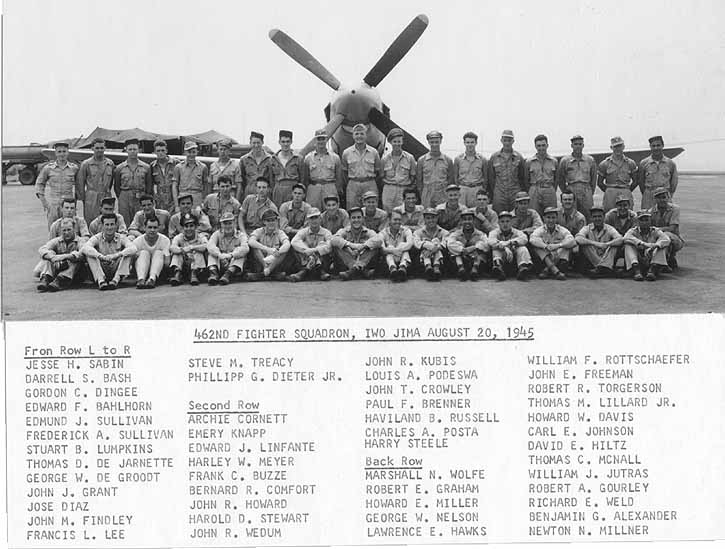
When the 457th Fighter Squadron was activated in October 1944, the Allied Offensive in the Pacific had brought America's bombers within range of the Japanese homeland. During the summer of 1944 U.S. forces had captured Guam (MAP)(Satellite View), Tinian (Map)(Satellite View) and Saipan (MAP)(Satellite View) in the Mariana's; from airfields built on these islands, B-29’s launched their devastating attacks upon the heartland of Japan. After Iwo Jima was secure in March 1945 the Army Air Forces had a forward base for use in providing fighter escort for the bombers. Late the following month the 506th Fighter Group, which was composed of the 457th, 458th, and the 462nd Fighter Squadrons, arrived at Iwo Jima (Map)(Satellite View) to take part in the aerial onslaught against Japan. The 457th Fighter Squadron was activated on 21 October 1944 at Lakeland Army Air Field, Lakeland, Florida. Personnel to man the unit came from the Third Air Force. Although the Squadron received only a small cadre during the first week of activation, by the end of November the unit had grown to sixty-five officers and two hundred sixty-two enlisted men. During the first two months of activation, the Squadron practiced long-range escort missions and instrument flying.
Historical Lineage of the 457th - still active and the only Squadron of the 506th that is December 1944 the 506th Group, including the 457th Squadron, received orders, which alerted it for overseas movement. The unit began a more intensified training program, which emphasized serial aerial strafing, skip bombing and navigation. Ground crews disassemble and reassembled the unit’s P-51's until they were thoroughly familiar with the aircraft and its parts.
Moving to the Pacific in stages, the unit departed Florida in February 1944, boarded ship at Seattle, and after a brief visit to Hawaii, arrived on Tinian (Map)(Satellite View) . The air echelon traveled with its Mustangs on CVE-68, Kalinin Bay while the ground echelon slogged across the Pacific in the transport Bloemfontein.
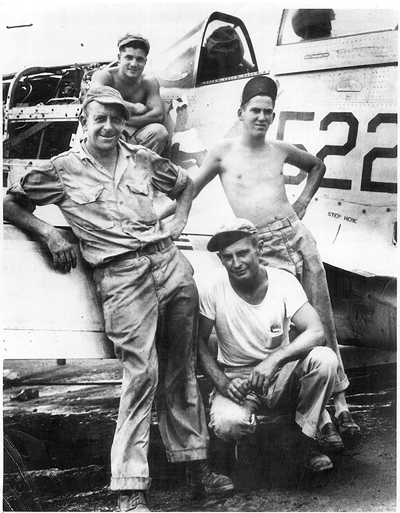
This is the crew responsible for their P-51 Mustang fighter plane, the only one in the squadron, to make 15 "consecutive" missions over the Japanese Empire from it's Iwo Jima base without a mechanical failure.
The airman began making bets on the degree of list necessary to capsize the old ship. Not until 20 April did the ground echelon arrive in the Mariana's, and after a brief stop they were en route to Iwo Jima (Map)(Satellite View), dropping anchor there on 24 April.
It was in the Mariana's that the squadron suffered it's first loss as 2nd Lt. Wilbur D. Mansfield was killed in a crash two miles west of Tanapag Harbor (MAP)(Satellite View). 2nd Lt. John Hall sustained serious back injury when he crash landed his P-51 on. Not until the 16th of May was the group reunited as the air echelon finally advanced to Iwo. A lack of air transport delayed the last of the Tinian contingent for another three days.
As the air unit pickled their P-51s and began flying CAP missions from West Field #4 on 27 Mar 1945. The ground echelon was suffering much seasickness in heavy seas. As the transport was caught repeatedly between swells, there was some breakage to equipment & some injuries.
Meanwhile, the air echelon flew coastal patrol missions from Tinian (Map)(Satellite View) in the Mariana's during the period from 27 March to 24 April.
On 5 May, however, the Squadron’s twenty-seven green-tailed aircraft joined the ground echelon on Iwo Jima.
At Iwo Jima, the 457th Squadron, as a unit of the 506th Group, was placed under the operational control of the Seventh Fighter Command and assigned to Twentieth Air Force. In addition to aiding in the defense of the island, the unit participated in the VII fighter Commands attacks on neighboring islands held by the enemy. To the north, 150 miles away, was Chichi Jima (Satellite) , where the Japanese Bonin Islands garrisons had their headquarters and where the enemy’s installations included a harbor, troop housing, radio and radar facilities, and the Susaki airfield. To keep this field inoperative, the VII Fighter Command’s aircraft flew daily bombing sorties against it.
The 457th began flying CAP missions immediately and was dispatched on its first combat strike to Chichi-jima (Satellite) Island on 19 May, a ten plane mission. The first night air raid followed on the 21 May with the realization that there were not enough slit trenches for everyone.
1st Lt. Horace F. Bozarth, was the next casualty, lost when his P-51 crashed in the sea off Iwo Jima on 22 May 1945.
There were a few more sorties to Chichi Jima and a planned VLR mission to Honshu, scrubbed by weather forecasts, and then the major event came - a mission for the 506th Group to attack an airfield on Honshu. It had been a long wait for the 457th , and to say the pilots were "up" for the mission wa an understatement. The group destroyed or damaged some 50 Japanese aircraft on Kasumigaura Airdrome losing only one plane & pilot (from the 462nd squadron). The only aerial encounter involved the 457th and Maj. Malcolm Watters shot down a Tojo.
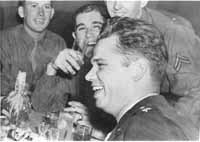
Maj. Malcolm “Muddy” Watters, Commanding Officer of the 457th Fighter Squadron.
(From Larry Grennan)
The 457th was euphoric about the results of their first showing against the enemy and deservedly so. The lack of any losses was also a sobering reminder of the dangers inherent in such operations.
Accompanying the 15th and 21st Fighter Groups on a Seventh Fighter Command maximum effort on 1 June 1945, pilots of the 506th became some of the pawns in a death dealing weather front. It was one of the most disastrous missions of the Pacific was for the AAF.
The mission of 1 June was to escort B-29's to Osaka (MAP). The 457th contributed nineteen planes to the Group’s escort mission and all were airborne by 0738* Rendezvous with the B-29'S was made over Kita Iwo Jima, 39 miles north of Iwo Jima. The planes' climbed to 12,000 feet and headed for Japan. At 1000 hours, approximately 400 miles from the base, the P-51's encountered a solid weather front. After the planes followed the navigator B-29's into the front, weather conditions suddenly seamed intolerable. Visibility dropped to zero. Sleet, hail, and rain poured down thorough the skies, Icing, and severe downdrafts made matters worse. The large formations of Mustangs began to break apart. Visual contact with the navigator planes was lost. Communications were disrupted. Of the two hundred P-51’s, which the VII Fighter Command sent out to escort the B-29's only twenty-seven succeeded in reaching Osaka. As a result of this abortive mission five of the Squadron’s pilots failed to return and were listed as missing. The 457th suffered the loss of 5 pilots, Lieutenants James Best, Robert Griffith, Leonard Kleiber, Robert Klipped and William Saks. Six other pilots and planes from the 506th Group were also not accounted for.
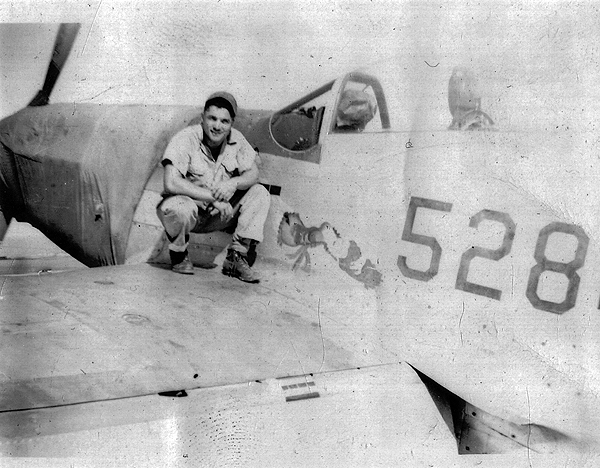
Sergeant Dewey Turilli, radio operator/p>
Just as the killer front was reached, Lawrence Grennan of the 457th developed a rough engine and turned back to Iwo Jima. The Merlin power plant failed him just 6 miles short of base and he was forced to parachute. A rescue ship had him aboard almost immediately, and Grennan was one of the lucky ones on a luckless day.
Malcolm Watters moved on to the 506th Group staff and Capt. Daun G. Anthony assumed command of the 457th Squadron.
Somewhat better weather conditions existed on ensuing strikes during June. While escorting B-29’s the Squadron flew to Osaka on 7 June and to Tokyo on 10 June. For its performance on repeated long range escort missions and its defense of AAF B-29s between June 7 & 10, 1945, the 506th Group won a Distinguished Unit Citation.
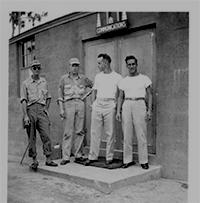 |
|---|
| Master Sergeant/Communications Chief |
During July the flying weather improved greatly. By that time, Japanese fighter opposition to the B-29’s was so negligible that fighter escort was unnecessary. Hence, the 457th began to devote itself almost entirely to strafing attacks against enemy airfields and other military installations. The strafing of enemy aircraft on the ground, however, proved to be very difficult because the Japanese dispersed their airplanes to areas some distance from the airstrips. The Squadron also conducted strafing missions against the Japanese transportation system and continued its regular missions to the Bonin's, keeping Susaki Airfield inoperative.
The squadron found it difficult to lure Japanese air forces into aerial engagements, so it continued to hammer enemy aircraft on Honshu's airfields. However, on July 16, 1945, near Nagoya, the 506th Group was jumped from above by Japanese Army fighters and destroyed ten with one probable and nine claimed damaged. The 457th scored five of the kills, with Capt. Abner M. Aust getting three victories. There was a price, however, as Capt. John W. Benbow was shot down (?) and killed.
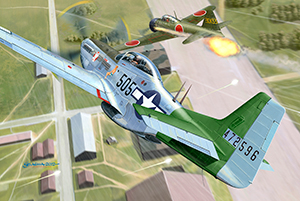 |
|---|
| Aust becomes Last WWII Ace |
CAPTAIN ABNER M. AUST JR., 457TH fighter Squadron: “I was leading Blue Flight in the second section of our squadron in the Nagoya area when six bogies were called out at nine o’clock low. I called my section to drop their tanks and we peeled off low on a flight of six Franks. I made almost a head on pass at their number one man and gave him about a two or three second quirt around the cockpit and he broke away to his right. As I turned to the left I was almost on top of another. I split-essed with him and got hits with a three second or more burst around the engine and cockpit area. After I passed him my flight saw him bail out. As I pulled up another was almost in front of me and as I closed in on him he split-essed and I followed him. I was getting hits all the way through and I finished up with a burst into the cockpit and I believe that I killed the pilot because he went straight into the clouds. As I pulled up another was coming almost head on and I fired a burst into his engine and he split-essed and I followed. I closed in on him and got hits in the right wing root and cockpit and he started smoking and burning in the right wing and fuselage, as he went straight into the clouds. We pulled off this one and I was almost behind another. As I closed in he split-essed and I followed him and he went into a dive. I got hits in the root of the left wing and before he went into the clouds I saw smoke coming out of the wing. I fired all my remaining ammunition at him and followed him down into the clouds to about 350 or 375 mph and elevation of the ground was about 1,000 feet. He was going almost straight down and made no move to shake us. I don’t believe he could have pulled out.”
The dangerous and increasingly unproductive airfield strafing missions continued through July and into August, as it seemed that the war would go on forever. 2nd Lt. Joe Winn was lost on 28 July (a POW), 2nd Lt. John Coneff was killed in action on 3 August, and Capt. Evelyn Neff was killed on 5 August.
The last major aerial engagement for the Seventh Fighter Command occurred on August 10, 1945 and the 457th played a dominant role, claiming five kills and seven damaged against Japanese fighters. They escaped without loss from the swirling air battle northwest of Tokyo. In this final aerial duel Abner Aust destroyed two more enemy aircraft to become an ace, the only one in the 506th Group.
When the war ended on August 14, 1945, the 457th Fighter Squadron had achieved a record of 13 kills and 17 damage claims in the brief weeks of air-to-air action. They had also destroyed or damaged many Japanese aircraft on the ground.
In August 1945, the Squadron conducted three fighter strikes and two B-29 escort missions. On 14 August the 457th escorted B-29’s on their last mission to Japan.
After the end of war against Japan, the 506th Fighter Group, including the 457th Squadron, remained on occupational duty at Iwo Jima. The unit returned to the United States aboard the USS Independence in December 1945 and was inactivated on 16th December at Camp Anza California.
Approximately 8 years later, on 20 January 1953, the unit, redesignated the 457th Strategic Fighter Escort Squadron, was activated at Dow Air Force Base Maine. Assigned to the Strategic Air Command’s 506th Fighter Wing, the Squadron began training with the F-84 fighter aircraft. The pilots flew cross-country navigational training flights refueling. During March 1952 the 506th Wing, including the 457th Squadron, moved to Tinker Air Force base, Oklahoma. Meanwhile, temporary duty assignments to distant staging areas had begun. In August 1953, the Squadron moved to Misawa, Japan, for a 90 day period. In November 1955 and again in August 1956, a detachment of or the Squadron’s pilots and crew was on temporary duty for Nielson Air Force Base, Alaska.
2nd Lt. J. A. MacMullen Killed on training flight of Hypoxia before the squadron left for Iwo. Oxygen supply failed at high altitude. |
Pilots of the 457th Squadron, 506th Fighter Group before a P-51D. (l. to r.) Top Row: John McHugo, Curtis Worthen, Bill Hutchinson. Kneeling: Evelyn Neff, John Benbow, and Tom Messall. Neff & Benbow were both killed over Honshu. In the air campaign from Iwo Jima 116 air crew members were lost to all operational causes; flak, fighters, accidents, and weather. (Dr. John Benbow) |
Sgt. Budd Baumgardner, propeller specialist. (From Budd Baumgardner) |
Lt. Wesley A. Murphey and “Nip-Nocker” (From Wes Murphey)
|
Lt Robert Klippel (lost on Black Friday mission picture taken a few days before he shipped out to Iwo |
Lest We Forget
2nd Lt. J. A. MacMullen - Dec 1944
Lieutenant James Best - 1 June 1945
Lieutenant Robert Griffith - 1 June 1945
Lieutenant Leonard Kleiber - 1 June 1945
Lieutenant Robert Klippel - 1 June 1945
Lieutenant William Saks - 1 June 1945
Capt. John Wesley Long Benbow - 16 July 1945
2nd Lt. John Coneff - 3 August
Capt. Evelyn Neff - 5 August
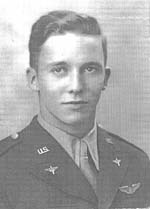
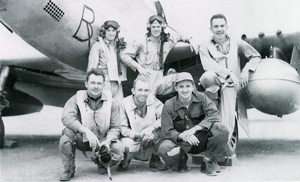
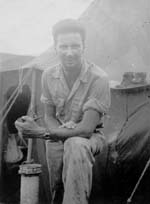
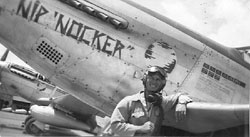
 << This is the only surviving photo of Capt Aust with his plane.>>
<< This is the only surviving photo of Capt Aust with his plane.>>